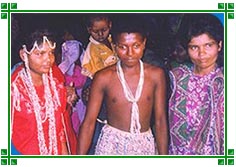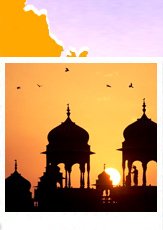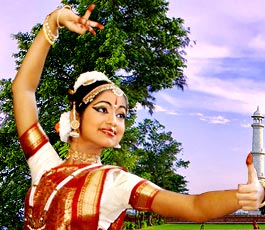 There are five primitive tribal groups that are
living in Andaman and Nicobar Islands, still following their unique
customs and traditions and resisting the wave of modernity and
civilization. These are: -
There are five primitive tribal groups that are
living in Andaman and Nicobar Islands, still following their unique
customs and traditions and resisting the wave of modernity and
civilization. These are: -Great Andamanese of Strait Island,
Onges of Little Andaman,
Jarawas of South and Middle Andaman,
Sentinelese of Sentinel Islands, and
Shompens of Great Nicobar.
Great Andamanese of Strait Island:
Having once the largest population amongst all the tribes of Andaman Islands, their numbers had dwindled from 10,000 in 1798 to 19 in 1969. The Administration has come forward to help these tribes in surviving and protecting and preserving their culture. These tribals have now been rehabilitated in a small island named Strait Island and are foragers. Though they have moved over to the modern food cooked with spices, they still go for hunting and gathering at times and their traditional food items consists of fish, dugong, turtle, turtle eggs, crabs, roots and tubers along with pork, Andaman water monitor lizard, octopus, molluscs taken out from shelled marine life such as turban shell, scorpion shell, sundial, helmet, trochus and screw shell and various types of crabs. Today, these people indulge in cultivating vegetables and poultry farming.
Onges of Little Andaman:
One of the most primitive tribes in India that belongs to the Negrito racial stock, they have been relegated to the reserved pockets at Dugong Creek and South Bay of Little Andaman Island and have been rapidly dwindling in numbers. The semi-nomadic tribes, fully dependent on nature for food, they are under the wing of Administration, which has provided them with pucca hut type houses, food, clothes, education and medicines. Their traditional food consists of turtle, fish, roots and jackfruits. The tribal artistry and craft has been developed but they are known for making canoes. However, their laid back and dependent nature is their biggest enemy.
Jarawas of South and Middle Andaman:
Recently turned friendly, Jarawas do not have canoes but use rafts to cross the streams. Administration stretched their hands to this tribe in 1974 and befriended them with gifts of bananas, coconuts and other fruits. They were hostile till 1998 but now they are coming out of their habitats to mix with the local people. Isolated from the civilized world, Jarawas appear to be healthy with smooth skin, deep curly hair, long and sturdy hands and legs and sturdy bones and are physically fit for hunting and fishing. This nomadic tribe is certainly not welfare-dependent and manages to subsist on hunting, fishing and gathering activities. Their traditional food consists of wild boar, turtles and their eggs, crabs, fruits and honey.
Sentinelese of Sentinel Islands:
Inhabitants of North Sentinel Island, they are the world's only Paleolithic people surviving today that have remained aloof from outside world and have no contacts with any other group or community. Said to be an offshoot of Onge and Jarawa tribes, the Sentinelese are very hostile and never leave their Island. Thus, most part of their culture remains shrouded in mystery.
Shompens of Great Nicobar:
Inhabiting the largest of Nicobar group of Islands, they belong to the Mongoloid race. They have two divisions - the smaller division of Mawa Shompens live very close to the coastal region along the river valleys and are very shy. However, they are intimate with the Nicobarese. The major group of Shompens is hostile and live in Alexendra and Galathia river areas and also on the east coast of the area in the interiors. Their numbers have dwindled greatly due to various diseases and they are physically very weak.









